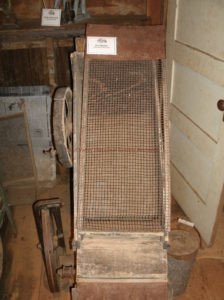

A drywasher is a common desert mining tool for gold mining.
A drywasher is like a highbanker, since it uses a motor and a form of sluice, but it has no need for water. It drywasher operates by the use of air. By forcing air to flow up through the material as it moves down the sluice, the heavier materials, like gold, will stay at the bottom and get trapped by the riffles while the lighter materials will flow up and over the riffles or be blown away. The lighter material that is not blown away will slowly flow down the sluice and fall out the end of the sluice.
Drywasher – A mechanical apparatus used for separating free particles of placer gold from dry sediments. Dry placers represent a major portion of all alluvial gold deposits around the globe. Extreme aridity in southern hemispheric regions of the planet causes a slower rate of erosion on placer deposits than if rainfall were plentiful and regional watersheds were hydrologically active. This absence of water directly correlates to the low moisture content of alluvial sediments and the short distance gold moves from its hardrock source.
A drywasher works on the principle of gravity separation. Since gold, at 19.1 specific gravity, is much heavier than most other minerals found in local sediments, a facsimile of certain natural conditions (which would involve the use of water, if it were available) can be mechanically reproduced with a simple machine using dry air instead of water as the medium of separation. The process of excavating dry, compacted sediments will often loosen or unconsolidate them. Then, as long as the material is sufficiently dry, these gravels can be processed with a drywasher in a relatively efficient manner.
